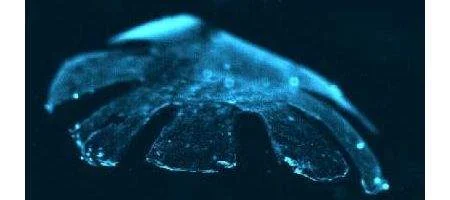Scientists have created a free-swimming ‘jellyfish’ out of silicone seeded with living heart muscle cells.

The Harvard University and Caltech team say that their work marks a big step towards the development of an artificial heart – and suggests a broader definition of what counts as synthetic life.
“I was surprised that with relatively few components – a silicone base and cells that we arranged – we were able to reproduce some pretty complex swimming and feeding behaviors that you see in biological jellyfish,” says professor John Dabiri of Caltech.
Jellyfish, believed to be the oldest multi-organ animals in the world, use muscles to pump their way through water. Surprisingly, perhaps, their basic morphology is pretty similar to that of a beating human heart.
To reverse engineer their medusa jellyfish – dubbed Medusoid – the investigators used analysis tools more generally used in law enforcement biometrics and crystallography to map the alignment of subcellular protein networks within all of the animal’s muscle cells.
They then took a sheet of cultured rat heart muscle tissue and incorporated a silicone polymer, fashioning the Medusoid’s body into a thin membrane like a small jellyfish, with eight arm-like appendages.
It was placed in a container of ocean-like salt water and successfully shocked into swimming with synchronized muscle contractions like those of real jellyfish – indeed, the muscle cells started to contract on their own even before the electrical current was applied.
The same strategy, says professor Kevin Kit Parker of Harvard, could be used to reverse engineer muscular organs in humans.
“As engineers, we are very comfortable with building things out of steel, copper, concrete,” he says. “I think of cells as another kind of building substrate, but we need rigorous quantitative design specs to move tissue engineering to a reproducible type of engineering. The jellyfish provides a design algorithm for reverse engineering an organ’s function and developing quantitative design and performance specifications. We can complete the full exercise of the engineer’s design process: design, build, and test.”
The researchers now plan to make the artificial jellyfish more sophisticated, allowing it to turn and move in a particular direction – and even incorporating a simple ‘brain’ so it can respond to its environment by, say, heading toward a light source or seeking food.






